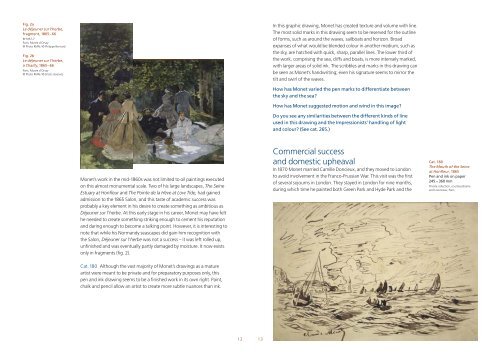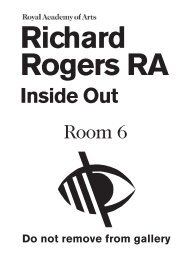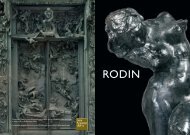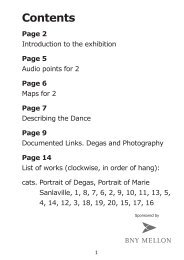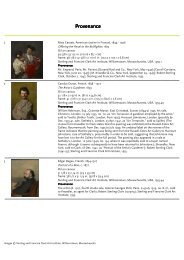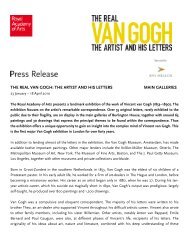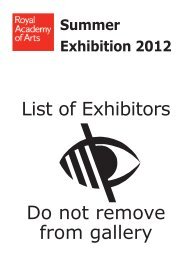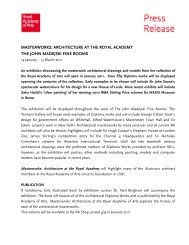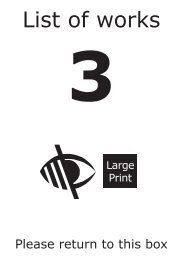Introduction to the Unknown Monet - Royal Academy of Arts
Introduction to the Unknown Monet - Royal Academy of Arts
Introduction to the Unknown Monet - Royal Academy of Arts
You also want an ePaper? Increase the reach of your titles
YUMPU automatically turns print PDFs into web optimized ePapers that Google loves.
Fig. 2a<br />
Le déjeuner sur l’herbe,<br />
fragment, 1865–66<br />
RF1957-7<br />
Paris, Musée d’Orsay<br />
© Pho<strong>to</strong> RMN / © Philippe Bernard<br />
Fig. 2b<br />
Le déjeuner sur l’herbe,<br />
à Chailly, 1865–66<br />
Paris, Musée d’Orsay<br />
© Pho<strong>to</strong> RMN / © Droits réservés<br />
<strong>Monet</strong>’s work in <strong>the</strong> mid-1860s was not limited <strong>to</strong> oil paintings executed<br />
on this almost monumental scale. Two <strong>of</strong> his large landscapes, The Seine<br />
Estuary at Honfleur and The Pointe de la Hève at Low Tide, had gained<br />
admission <strong>to</strong> <strong>the</strong> 1865 Salon, and this taste <strong>of</strong> academic success was<br />
probably a key element in his desire <strong>to</strong> create something as ambitious as<br />
Déjeuner sur l’herbe. At this early stage in his career, <strong>Monet</strong> may have felt<br />
he needed <strong>to</strong> create something striking enough <strong>to</strong> cement his reputation<br />
and daring enough <strong>to</strong> become a talking point. However, it is interesting <strong>to</strong><br />
note that while his Normandy seascapes did gain him recognition with<br />
<strong>the</strong> Salon, Déjeuner sur l’herbe was not a success – it was left rolled up,<br />
unfinished and was eventually partly damaged by moisture. It now exists<br />
only in fragments (fig. 2).<br />
Cat. 180 Although <strong>the</strong> vast majority <strong>of</strong> <strong>Monet</strong>’s drawings as a mature<br />
artist were meant <strong>to</strong> be private and for prepara<strong>to</strong>ry purposes only, this<br />
pen and ink drawing seems <strong>to</strong> be a finished work in its own right. Paint,<br />
chalk and pencil allow an artist <strong>to</strong> create more subtle nuances than ink.<br />
12<br />
13<br />
In this graphic drawing, <strong>Monet</strong> has created texture and volume with line.<br />
The most solid marks in this drawing seem <strong>to</strong> be reserved for <strong>the</strong> outline<br />
<strong>of</strong> forms, such as around <strong>the</strong> waves, sailboats and horizon. Broad<br />
expanses <strong>of</strong> what would be blended colour in ano<strong>the</strong>r medium, such as<br />
<strong>the</strong> sky, are hatched with quick, sharp, parallel lines. The lower third <strong>of</strong><br />
<strong>the</strong> work, comprising <strong>the</strong> sea, cliffs and boats, is more intensely marked,<br />
with larger areas <strong>of</strong> solid ink. The scribbles and marks in this drawing can<br />
be seen as <strong>Monet</strong>’s handwriting; even his signature seems <strong>to</strong> mirror <strong>the</strong><br />
tilt and swirl <strong>of</strong> <strong>the</strong> waves.<br />
How has <strong>Monet</strong> varied <strong>the</strong> pen marks <strong>to</strong> differentiate between<br />
<strong>the</strong> sky and <strong>the</strong> sea?<br />
How has <strong>Monet</strong> suggested motion and wind in this image?<br />
Do you see any similarities between <strong>the</strong> different kinds <strong>of</strong> line<br />
used in this drawing and <strong>the</strong> Impressionists’ handling <strong>of</strong> light<br />
and colour? (See cat. 265.)<br />
Commercial success<br />
and domestic upheaval<br />
In 1870 <strong>Monet</strong> married Camille Doncieux, and <strong>the</strong>y moved <strong>to</strong> London<br />
<strong>to</strong> avoid involvement in <strong>the</strong> Franco-Prussian War. This visit was <strong>the</strong> first<br />
<strong>of</strong> several sojourns in London. They stayed in London for nine months,<br />
during which time he painted both Green Park and Hyde Park and <strong>the</strong><br />
Cat. 180<br />
The Mouth <strong>of</strong> <strong>the</strong> Seine<br />
at Honfleur, 1865<br />
Pen and ink on paper<br />
245 × 360 mm<br />
Private collection, courtesy Brame<br />
and Lorenceau, Paris


